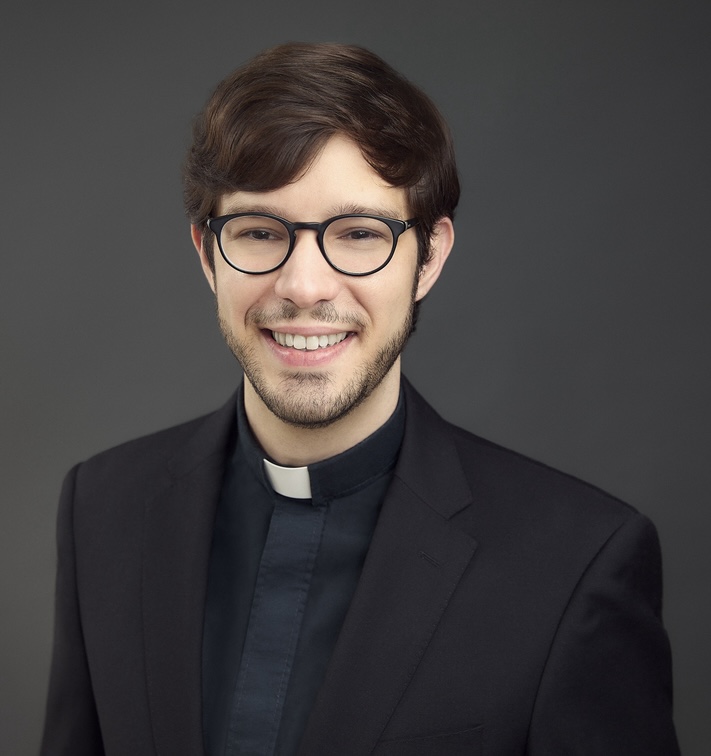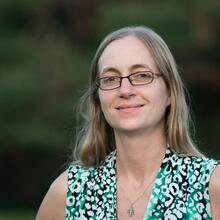This essay is a Cover Story selection, a weekly feature highlighting the top picks from the editors of America Media.
Editors’ note: One of the recommendations of the first meeting of the Synod on Synodality was to explore ways to improve the quality of liturgies. Building on that proposal, America asked two contributors, Rachel Lu and Matthew Cortese, S.J., to reflect on the following question: How can we make the liturgy more reverent? Informed by their own experiences of Mass in various traditions and inflections, as well as church documents from the Second Vatican Council and Popes Benedict XVI and Francis, both then shared their reflections with one another. What follows is their conversation.
Liturgy should not cater to our personal preferences
I remember memorizing my prayers as a catechumen 20 years ago. Books helped me to familiarize myself with the parts of the Mass, which initially seemed foreign and alienating. This is normal for converts, and I’m grateful to have had those resources, but my children will have no such memories. To them, Ave Maria, gratia plena, Dominus tecum will seem like words that they always knew. Agnus Dei, qui tollis peccata mundi will feel like part of the fabric of the universe. I love that. Because it is true, and no book can teach that as effectively as reverent liturgy.
“I ask that you be vigilant,” writes Pope Francis in “Traditionis Custodes,”his 2021 letter to the bishops of the world, “in ensuring that every liturgy be celebrated with decorum and fidelity to the liturgical books promulgated after Vatican II, without the eccentricities that can easily degenerate into abuses.”

It seems to me that reverent liturgy has become a topic of renewed interest among Catholics, which is wonderful to see. We live in uncertain times, and the church faces many challenges, but nothing will sustain us through these trials like the fitting worship of God.
There are of course many facets to the debate about reverent liturgy, but two things in particular seem worth stressing. First, liturgy should be beautiful. Second, it should draw worshipers beyond themselves and into a relationship with things that transcend their particular place and time: the universal church, a rich Catholic tradition and, most importantly, God himself.
Liturgy can only be reverent when its goal is to revere. It can be difficult for people today to grasp this point, living in an age saturated in commercialism, materialism and myriad forms of entertainment. We expect as a matter of course that our tastes and preferences will be catered to, and it can be difficult to let that go. Having said that, there is nothing uniquely modern about the temptation to prioritize personal or community preferences over our duty to honor God.
In The Spirit of the Liturgy, written before he became pope, Benedict XVI makes this point by referencing the story from Exodus 32 in which the Israelites, sitting restless at the foot of Mount Sinai, create a golden calf and celebrate “a festival to the Lord.” Benedict notes that, at least according to Aaron, it is the Lord who is being celebrated, not Baal or Ra; the people are still ostensibly faithful to the God of Israel. But their feast is condemned, not accepted as real worship, because God never asked to be worshiped in that way. The golden calf is simply invented by a (mere) man as a morale-raising measure. Reverence has little or nothing to do with it.
Worship is difficult. It isn’t always clear to us what God wants, and that uncertainty can open wide avenues to liturgical adaptations that are more ordered toward self-expression or communal catharsis than the honoring of our Creator. There is no simple resolution to this problem, but for the laity especially, I believe that the clearest and most obvious way of revering God in the Mass is by kneeling to receive his body, ideally on the tongue. Kneeling is an ancient practice, once used to honor kings. We still strongly associate it with both humility and reverence. It is unusual for Americans, since we no longer kneel before earthly dignitaries, but that only makes the gesture more effective. When we kneel before God, we clearly perceive the uniqueness of the occasion. With the help of altar rails, Communion can be distributed very efficiently to kneeling parishioners, and as a mother with young children I found that method far less anxiety-inducing than a Communion line. I had time to find my space at the altar rail and settle my children around me before my turn came. Then I could lead them away without feeling that I was holding up the show.
Looking back to the pre-Vatican II world, there are many other traditions and practices that I would like to bring back. Perhaps the point most worth stressing, however, is that something should be brought back, even if that something varies a bit from region to region and from rite to rite. There is no reason why Mass must be perfectly standardized across the entire world, and I am happy to see the Byzantine, Chaldean, Armenian and Maronite flowers bloom. Jesus had many apostles, and their evangelical efforts laid the foundations for many different (but still beautiful) liturgical traditions.
But the rapidity of liturgical change after Vatican II created what Pope Benedict XVI called the “hermeneutic of discontinuity.” In plainer terms, it seemed to many of the faithful as if all-new liturgical rites had simply been made up, as part of an effort to “get with the times.” Some found this disturbing and others welcomed it, but regardless of how anyone felt, the rapid transition had the unhappy effect of diminishing Catholics’ sense of liturgy as something that transcends time, place and our fallen world. Bringing back pieces of established liturgical traditions would help to re-establish that sense of transcendence.
This should go beyond Mass to encompass traditional prayers and devotions, such as the rosary. We should also rediscover the beauty of liturgical languages. Roman Catholics, in my view, should have at least some exposure to Latin, which is part of our heritage. Catholics should experience the profound joy in worshiping God in the very same words used by countless saints and faithful across the centuries, which also helps our easily distracted human minds grasp the reality of truths that endure across centuries.
Of course, we can still have some liturgy in the vernacular. But if parishes were encouraged to offer, say, one Mass each week using the Latin Ordinary (the current texts of the Roman Missal in Latin, of which the vernacular liturgy is a translation), most Catholics would presumably become comfortable with it. Children should also be taught basic prayers (at least the Ave Maria and the Pater Noster) in Latin, which will deepen their sense of standing with the rest of the universal church on the plain of eternity. Liturgical languages make intuitive sense to children; it seems right to them that there should be special words for honoring God. We should take advantage of that to form their sensibilities in ways that can endure for life.
Liturgy should not be frozen in amber, but it should be immensely respectful of tradition. Embedded within liturgical tradition are certain divinely inspired truths about how God wishes to be worshiped; and in striving to honor that, we open the possibility of reverence.At the same time, receiving and protecting liturgical traditions helps us to grasp the transcendent nature of liturgy. Worship is good for human beings, but we reap its full benefits only when our goal is to honor God. This is a truth that both Pope Francis and Pope Benedict have tried to communicate to the church, and by embracing it, we may find in our liturgy a tremendous source of grace and spiritual renewal.
Rachel Lu is a freelance writer, an associate editor at Law & Liberty and a regular contributor to National Review. She lives in St. Paul, Minn.
Reverence Is More Than Beauty
As I think about reverence in the liturgy, a memory comes to mind. I was in elementary school, probably around 11 or 12 years old. My father was one of the leaders of our parish folk group, which would gather in the church basement every Sunday before morning Mass to tune guitars and run through the chosen songs. I learned a lot of liturgical music in that basement, and even more at Wednesday night rehearsals—and, of course, during the liturgy itself. But the song that comes to mind in this particular memory is an alleluia, a Gospel acclamation penned by the Dameans, which is No. 175 in the Glory & Praise hymnal published in the 1980s.
I can’t say that I would advocate for the song’s continued use. It has a decidedly ’70s tenor, one that perhaps verges on treacly. But there’s something about the chord progression that I still find entrancing: the bold use of a D major chord in the key of E, and the repetitive back-and-forth between E and F#m7. And then there is the first verse—the one I remember being used most often in our parish during the Gospel procession—taken from Psalm 118. The translation of the psalm—the paschal psalm par excellence—still sticks in my mind: “Give thanks to the Lord for he is good/ His mercy endures forever./ Let the house of Israel say,/ His mercy endures forever.”

I still feel the vibrations of the strings, and the truth of the words, and I know in my bones that the singing of the Dameans’ alleluia was reverent. Although not musically exquisite in the classical sense, it was nonetheless compelling and worshipful. It accomplished what excellent—or even, in my experience, mediocre—Gregorian chant can accomplish: a fostering of the love of God in the hearts and minds of those singing and hearing and praying. And the acclamation taught one Catholic child God’s word, and how to honor it—and in so doing to “honor…our Creator.” I know in my bones that those folk Masses of my youth were indeed “ordered” toward God and not “toward self-expression or communal catharsis.”
I often find conversations around reverent liturgy to be decidedly slippery. On my more pessimistic days, it seems to me that the word reverence can be imprecisely used as the equivalent of “liturgical things I like” or “things that feel Catholic to me.” Dr. Lu offers a helpful and nuanced corrective to my (perhaps Jesuitical) pessimism. While she notes that “the debate about reverent liturgy” is decidedly multifaceted, she highlights two important, relevant elements: Reverence in the liturgy involves both beauty and an invitation to transcendent relationship.
I wholeheartedly agree. I worry, however, that reverence can too easily and too frequently be reduced to beauty alone, to mere aesthetics, to one’s preferred style. I worry that a monolithic view of the Catholic liturgical tradition can quickly morph into its own golden calf, in which living tradition comes to be misconstrued and misused as a “morale-raising measure” among people (on all sides) who fear a diversity of Catholic views and a multiplicity of Catholic practices, who—like those at the foot of Sinai—confuse their own account of the shiny and the beautiful with the word of the living God.
What, then, is reverence? I find myself returning to St. Ignatius Loyola’s Spiritual Exercises, a text saturated with reverence. “Human beings are created to praise, reverence, and serve God our Lord, and by means of doing this to save their souls,” Ignatius writes. Reverence, for Ignatius as for Dr. Lu, is keenly associated with creaturehood, the duty to honor their creator that belongs to every creature, and especially to the human person. It is what the fallen angels lacked, caught up as they were in their pride.
St. Ignatius asks the person making the Spiritual Exercises to imagine him or herself as a little girl serving the Holy Family at the birth of Christ—someone who had reverence in spades. Each prayer period is concluded by making “an act of reverence or humility”—a movement, a gesture, especially associated with an act of the will.
Reverence is, for St. Ignatius, a disposition, one that principally manifests itself in gesture and action. I think particularly of his instructions for the application of the senses, when one is invited to reflect upon the imaginative contemplation one has completed. One is invited to imagine the very “places where the persons”—e.g., Jesus or Mary—“walk or sit,” and one is to imagine oneself touching those places—embracing and kissing those places in one’s memory, mind and heart. Though Ignatius does not here use the word reverence, he is obviously describing it: to cultivate and to surrender to an overwhelming love of and honor for Jesus, expressed in thought, word and gesture.
What I find most helpful about St. Ignatius’ view of reverence is that he does not, in the Spiritual Exercises, insist on a uniformity of reverent gesture. While he cherished his own late-medieval Spanish piety—a devotional world that is, to many postmodern American Catholics, both beautiful and foreign—he does not define the “act of reverence” to be made at the end of prayer. He does not define one single Catholic way of being reverent. He is supremely and “immensely respectful of tradition,” while also allowing for variation in time, place, culture and temperament. This, it seems, is key, as Dr. Lu has noted: to respect local and ritual variation while concurrently maintaining Catholic unity—a localism that always and everywhere transcends itself.
There is, as Dr. Lu points out, the ever-present temptation for all of us “to prioritize personal or community preferences.” I am certainly not immune from that. Indeed, I might go even further: There is the temptation to see one’s own personal experience or taste as the Catholic tradition, to confuse spiritual growth with an influx of sentiment and to use nostalgia to justify either the flavor of the age, or the flavor of a past age or the status quo. And I heartily agree with Dr. Lu that there is much liturgically to recover. Following Vatican II’s “Constitution on the Sacred Liturgy” (“Sacrosanctum Concilium”), Gregorian chant tops my list, not as a replacement for all vernacular song but as a necessary, traditional enrichment.
I hope that Catholic children learn to chant the Sanctus and the Agnus Dei and the Pater Noster, both in Latin and in their respective vernaculars, to be employed as the liturgical circumstances demand. Reverence, however, can be cultivated in a multiplicity of languages and in manifold ways and cannot be limited to one aesthetic or style. “For Christ plays in ten thousand places,” as Gerard Manley Hopkins says, “lovely” even in the treacly.
Matthew Cortese, S.J., is a Jesuit priest (USA East Province) from eastern Long Island, N.Y. He currently studies theology and liturgical studies at The University of Notre Dame.
Against Bad Liturgy
Midway through our exchange, it seems Father Cortese and I are in danger of being in serious agreement.
My initial reflection stressed the significance of reverence, beauty and tradition as a means of ensuring that worship is oriented toward God. I cautioned against allowing worship to devolve into a form of community catharsis, or a “spiritual experience.” Father Cortese seems largely in agreement, and he also shares my desire to see Catholics recover their appreciation of liturgical languages, ancient prayers and traditional sacred music, like Gregorian chant. He merely cautions that traditionalists can also be tempted by the golden calf of “personal preferences.” Sometimes liturgical purists treat their recommended way of worship as the only good or authentic one, but Father Cortese reminds us instead that Christ “plays in ten thousand places,” and in a wide range of languages and styles.

I happily concede the general point. Liturgical snobbery is a real phenomenon, one that can become self-righteous and prideful. Father Cortese’s reflection underscores another important point as well: It is impossible to know from the outside what impact different forms of liturgy might have in particular souls.
“I know in my bones,” he writes, “that those folk Masses of my youth were indeed ‘ordered’ toward God and not ‘toward self-expression or communal catharsis.”” He presumably wishes to avoid scenarios in which a community is ordered to discontinue liturgical practices that are meaningful to them, and I agree that sharp, sudden changes in liturgical practice are undesirable and will often cause real spiritual harm.
Nevertheless, I may spy a point of disagreement worth exploring. We agree that beauty, reverence and transcendence are all critically important for worship. But is there such a thing as bad liturgy? Can it be appropriate to discourage people from worshiping in a particular way? Maybe we don’t entirely agree about that.
There are many reasons, certainly, to be careful and circumspect in the judgments we make about liturgy. Worship can be an intensely personal experience, even in a community setting, and we can never be certain what a particular practice means to a particular person. We do know that human beings have a deep desire to praise and honor their Creator, and that God also wishes to draw human souls back toward himself. So it is not surprising at all that grace often works through a wide variety of liturgical celebrations, including some that are not Catholic or even Christian. I still remember songs and prayers from my Mormon childhood, which continue to move me especially because they were my entry point to loving Jesus. I often think that children in general have the purest prayers of all, regardless of the precise form, because they have so much less experience of fallenness and sin.
It would not be fitting, however, for adults to content themselves forever with “Angel of God, my guardian dear” or (with a hat tip to the Mormons) “Jesus wants me for a sunbeam.” Adults need adult-sized prayers and forms of worship, and as we grow we need to continue to cultivate and deepen our sense of the sacred as something set apart, holy and distinct from the everyday. Not all liturgical practices do this equally well.
For instance, liturgical music that sounds like something one would hear on the radio or sing around a campfire does not convey the sense of the Mass as something distinct, transcendent and sacred as effectively as Gregorian chant. Kneeling tends to inspire a sense of reverence more than standing in a line does. More generally, it is easier to have a sense of liturgy as something that transcends our own time and place when we have inherited it across generations instead of making it up ourselves or inheriting it from the generation immediately before us. Sometimes, careful consideration of these points may lead to a reasoned judgment that certain liturgical practices are not fitting and ought to be discontinued. They do not honor God as well as they could or lift human hearts as readily. In some cases, a particular practice might be healthy and appropriate for some setting, but not for Mass.
It is important to look on our fellow Catholics with charity and to recognize that it is not our prerogative to decide where and how Christ can work. But it is not always snobbish or prideful to be offended by a liturgical practice. If a person has cultivated a powerful sense of the sacred, he will inevitably see certain things as inappropriate in times or places that should be set apart for God.
In an unfamiliar cultural setting, I would naturally be slow to pass judgment, but I have memories of Masses that involved music, dancing and a general aesthetic that to me was powerfully reminiscent of a library story hour or a kindergarten. I have been to Masses that felt like a pop concert with some prayers added. I cannot say what others were experiencing, but to me there was a strong sense of profaning what is sacred. There is nothing wrong with pop concerts or library story hours, but what reason do we have for thinking that God has asked us to worship him in those ways? How do those celebrations convey a sense of sacred time and space, as something set apart for our Creator?
We cannot grow closer to God by scorning our neighbor, and we should always trust in God’s willingness to accept our imperfect offerings and turn our half-converted hearts back toward him. Even so, it is sometimes appropriate to ask—or even demand—that the sacred be preserved as something set apart. We owe this to the Catholics who have gone before us and to God himself, who has honored us with his presence in our midst. - Rachel Lu
The Case for Diversity
Dr. Lu’s response gets to the heart of the matter, a point of tension in the midst of our substantial agreement. (And it is worth emphasizing, as she does, that our agreement is substantial!). I wonder, however, if the sticky-wicket question is not “Is there such a thing as bad liturgy?” (more on that below), but rather “What constitutes ‘profaning what is sacred?’” Here, indeed, we might not be in full agreement.
Profanation, it seems to me, is a pretty high bar. To return to the story of the golden calf, that original profanation, idolatry is what elicits fiery concern on the part of Moses and of God: “Come, make us a god…” (Ex 32:1). Whether or not Aaron and the people think that they are worshipping the living God, they are not. While, from the perspective of worship, idolatry certainly poses stylistic problems, the chief concern is one of substance. It is not only how the God of Israel is worshiped, but also what is worshiped: the living God versus the work of human hands. It was not simply that the people at the foot of Sinai were praying in the wrong language or singing the wrong type of music; it was, rather, that in their idolatry, God became (to borrow Hosea’s turn of phrase) no longer “I am” for them (Hos 1:9).

I wonder, then: Can liturgical style profane? “I have memories,” Dr. Lu writes, of Masses that were “powerfully reminiscent of a library story hour or a kindergarten” or of “a pop concert.” She continues: “I cannot say what others were experiencing, but to me there was a strong sense of profaning what is sacred.” I wonder if here a further distinction might be helpful, one drawn straight from the Constitution on the Sacred Liturgy. The council fathers of Vatican II state that Gregorian chant ought to be given “pride of place” in the Roman liturgy, that it is “specially suited” or “proper” to the Roman Rite (No. 116). To say that Gregorian chant is proper to the Roman liturgy is not to say that other liturgical musical styles are profanatory. To claim that one style is proper is not to say that other styles are unfit for God’s presence or tantamount to idolatry.
Further, to say that Gregorian chant is to be given “pride of place” is not to say there is no place for other musical styles. Thus, while I am fully willing to affirm—with the fathers of Vatican II—that Gregorian chant is “specially suited” or “proper” to the Roman Rite, I am not willing to say that other styles cannot “convey the sense of the Mass as something distinct, transcendent and sacred”—nor even to say that other styles cannot convey such a sense “as effectively.” One can, it seems to me, both affirm Gregorian chant’s “pride of place” and make liturgical space for other styles. Here I think not so much of the folk Mass music of my youth, but rather of the Vietnamese elevated speech known as đọc kinh that makes the Mass in that language so poignantly beautiful.
In a similar vein, one can both affirm that kneeling—a venerable Western posture of piety—“tends to inspire a sense of reverence” and say that standing (in line or otherwise) can also be profoundly reverent. I think of experiences I have had in Latin America in which the rush to line up for Communion, and the controlled chaos it brings, is something of great beauty: the people of God hurrying to and waiting on their Lord.
To say, with Gerard Manley Hopkins, that “Christ plays in ten thousand places” is more than just a “general point” that honors the personal or communal preferences of particular individuals or communities. It is to make a central point about the incarnation: that Christ takes on all that is human and makes it God’s very own, that Christ has truly assumed all human tongues and chants—even liturgically. It is to say that God can make even folk and pop redound to God’s glory in the Mass—that “all languages and styles,” even the music heard “on the radio,” “around a campfire” or at a “pop concert,” can be taken up into God’s liturgical project. (I think of the Steubenville Youth Conference liturgies of my adolescence.) This is a bullet that, on principle, I am willing to bite.
This is not, however, to say that we should be stuck playing the B-side tracks of the Dameans in perpetuity. This is not to say that we should aim for liturgies that approximate “a library story hour or a kindergarten.” It’s rather to argue that certain styles—musical and otherwise—should not be rejected out of hand as profanatory or straightaway excluded from the liturgy. It is to affirm that diverse and multiple styles can liturgically “set apart” “time and space” for God.
By way of conclusion, I want to return to Dr. Lu’s question: “Is there such a thing as bad liturgy?” Here, I think, Dr. Lu and I will find some terrain of further agreement. When I reflexively considered the question, my mind was drawn immediately not to musical style or to the gestures of the assembly, but rather to the role of the priest-celebrant. While any validly celebrated liturgy can be efficacious regardless of stylistic considerations, I would venture to guess that, at some point, we have all experienced Eucharistic presiding that was less than ideal. (And some of us, myself certainly included, have at times presided poorly!)
I think of additions and alterations—for example, the ad-libbed hospitality vamp at the beginning of liturgy (“Good morning! Welcome to Mass!”). This forced informality, it seems to me, comes across as more jarring than relatable. Conversely, I think of rigid formality in word and gesture, which conveys the extraterrestrial rather than the supernatural.
I think of unnecessary commentary, a sort of addiction to explanation that turns a holy desire (for the assembly’s comprehension) into an avalanche of words. I think of Shia LaBeouf’s now infamous line—both unfair to the Missal of Paul VI as it is written and not untrue with respect to practical implementation—that he prefers a Mass in which the priest does not seem like a car salesman.
I think that we—priests and people together—still have a lot of work to do to appropriate and live more fully the letter and the spirit of the liturgical rubrics and norms. But equally important is the call to listen more attentively to one another, to attend mutually to our liturgical joys, hopes, griefs, and anxieties, to pay attention to each other’s liturgical desires. I am grateful to Dr. Lu for this exchange, one such opportunity for mutual engagement. - Matthew Cortese, S.J.








